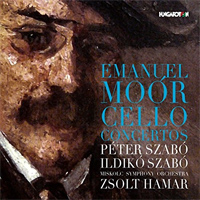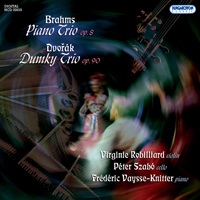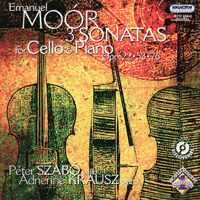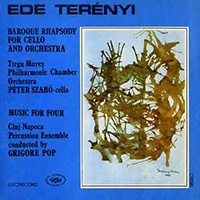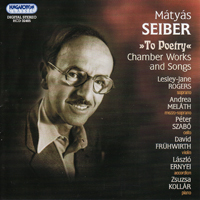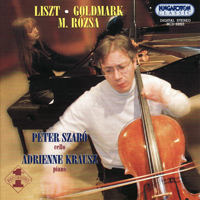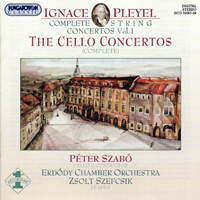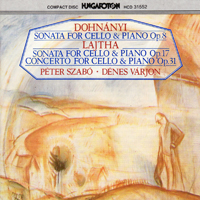The sound of music
About the disc of Emanuel Moór’s (1863-1931) sonatas for cello and piano (Hungaroton/HCD 32462) – Péter Szabó (cello), Adrienne Krausz (piano)
The other day I had the opportunity to interview Péter Szabó. Almost as usual, we met in the Budagyöngye café to talk about the recently released Moór CD. It was also rather usual that talking to the renowned cellist I immediately got into a wide European perspective. Szabó has talked about his plans and achievements; the goals are far above the habitual, the general. As a major part of our lives become real inside us, the work and the growing importance in the international musical world result from the self-explanatory hierarchy of ambitions that Szabó possesses.
When asking about the almost completely forgotten composer, Emanuel Moór, I do not just get an ordinary answer. “He was a frequently performed and popular composer of the time, when his popularity rivalled many internationally composers known now at the our present time.” “Why did he disappear then?” “He was a surprisingly intolerant, unaccomodating person.” The composer, who was incidentally an excellent pianist as well, played together with world-wide celebrated musicians. It was probably Pablo Casals who had the most significant role in introducing his art to the world. Moreover, Casals acquainted the composer with the famous musicians of the time, which inspired him to write again. The interpretations of the musical history avoid the issue of the gradually deteriorating relationship between Moór and Casals. “What could have been the real reason?” –I ask Péter Szabó. He seduced the cellist’s wife. No wonder that he stopped playing Moór pieces – notwithstanding that he appreciated this kind of art all the time. With the worsening relationship with Casals he began turning rather to his inventions; among other things to the two-manual piano, which was a popular instrument of his time.
“After this, how did you discover Moór? – Casals talked about him with surprising spirit, so I started to search for his pieces. He was an incredibly prolific composer, whose works could be found all over Europe. –Are they mainly in manuscript? –No, a vast number of his pieces were published at the time, but most of those publishing houses do not exist now. Consequently it was very difficult to hunt them down. But I had some good help.”
On the recording we can listen to the early pieces right from the turn of the century. His tutored and conscious structural method and his rich and dense harmony constructions are typical linguistic characters which give special importance to colours and acoustic stresses. The pianist Adrienne Krausz surrounds Szabó’s usually deep tone dialect with an almost dance like light elegance. The dynamic peaks are supported by the piano line with great mathematical accuracy. I have been listening to Szabó’s performances for years and I find his voice richer and more unique now. The explosive strength remained part of the exposition, but the sound grew more colourful and shifting. Meanwhile the whole acoustic body bears a characteristic inner quality. It would be a great stylistic mistake to talk about the two instruments separately, for they create organically unified system together. Moór is definitely a composer who imagines his works in an acoustic space, the musical events –both micro moments and grand surfaces –gain meaning from performance. Or to be more precise, this music waits from its very conception to occupy space and sound. This kind of art does not have a theoretical moment; during its creation the composer gave so much emphasis to the acousic feature that we can be sure, he must have had a really solid appreciation. From this point of view it is clear that he only composed when true need emerged. At first it was Casals and his connections which inspired him to give serious thought to composing. Later, his awkward nature and deteriorating friendship with the world famous cellist turned him more to inventions. “The two-manual piano in Budapest is a Stainway product; every significant piano manufacture bought its licence from the composer, which shows the quality of his work as an inventor”- Péter Szabó says.
Moór’s music is neither avant garde, nor traditional. The sound construction, the functional universe is slightly academic already from the turn of the century’s approach, but even more so from our perspective. But it is the autonomy which, as it were, validates the interior and the musical material’s hidden message. Behind this highly sensual musical material which exists merely to give body and voice, and cause magical moments, behind this simply beautiful music, there is autonomity. It basically stands apart from time and stylistic conceptions. In this case dialectics will provide an answer to the question, it carries its own opposite. The tangible forms of expression – acoustic balance, functional richness, ornamented melodies and invention – are almost immorally beautiful. It is not the ethical power that holds the music together, rather the expressive intensity, which is an integral part of the aforesaid artistic goal. Emanuel Moór was an awkward and impossible person; the type of person who wants to manipulate and control his environment and build a microcosm that gives a secondary place to the real world. And no matter how nice and valuable the music is, it is something that penetrates. This is the real reason for his subsequent disappearance. Still, Péter Szabó is right, he discovered very rich and valuable musical material, including several unrepeatable moments typical of the era, full of content and expression.
I hear the music, the expressive presentation, and spaces, universes open up. It is a pompuous world of functional decadence, but one of incredible depth. The era was obviously pervaded by decadence. But here, this dos not matter –only there appears too much liveliness, emotion and feeling simultaneously in the language. This kind of art has no time to pay attention to anything else; while every piece of its existence is attached to the auditive world, it is completely independent of anything else. This discrepancy serves as a message from the epoch, a decadence lying deep in the fate of the artist and his process of creation.
Emanuel Moór is given voice again – now he exists.
Domonkos
Source: www.hzo.hu
Translation by Susan Kapás
Hangszer és Zene
March 2008


